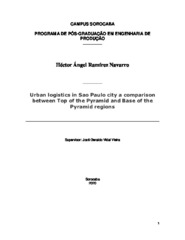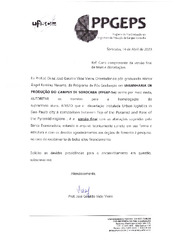Mostrar el registro sencillo del ítem
Urban logistics in Sao Paulo city: a comparison between Top of the Pyramid and Base of the Pyramid regions
| dc.contributor.author | Navarro, Héctor Ángel Ramírez | |
| dc.date.accessioned | 2020-05-04T12:24:34Z | |
| dc.date.available | 2020-05-04T12:24:34Z | |
| dc.date.issued | 2020-03-12 | |
| dc.identifier.citation | NAVARRO, Héctor Ángel Ramírez. Urban logistics in Sao Paulo city: a comparison between Top of the Pyramid and Base of the Pyramid regions. 2020. Dissertação (Mestrado em Engenharia de Produção) – Universidade Federal de São Carlos, Sorocaba, 2020. Disponível em: https://repositorio.ufscar.br/handle/ufscar/12677. | * |
| dc.identifier.uri | https://repositorio.ufscar.br/handle/ufscar/12677 | |
| dc.description.abstract | The fast expansion of urban areas poses challenges for Fast-Moving Consumer Goods (FMCG) companies who want to provide products to small retailers, especially in the last-mile delivery, which is a complex process that is hindered by factors such as transit regulations; city infrastructure; and safety. These factors have different levels of impact, between high-income and low-income neighborhoods and are more evident in megacities in developing countries, where it exists a clear division between classes. On one hand, governments do not attend low-income neighborhoods, where it exists a strong presence of unsafe areas, lack of planning, and infrastructure that hinders the deliveries of FMCG. On the other hand, traffic regulations in high-income neighborhoods make the delivery process more complex. This study aims to analyze the urban logistics by comparing lowincome and high-income neighborhoods in Sao Paulo city, by taking into account local businesses, buying consumer behavior, and the distribution process. To achieve this, a questionnaire in loco will be applied to the stakeholders involved (consumers, small retailers, and carriers). The data will be analyzed by employing descriptive statistics in an exploratory and descriptive way. The results from small retailers, consumers, and carriers reveal that in their point of view the delivery of products is different between BOP and TOP. Factors such as the infrastructure of the neighborhoods hinder the delivery of products from companies to small retailers in TOP regions, while in BOP regions small retailers' security and infrastructure are the major problems in the point of view of the actors. | por |
| dc.description.sponsorship | Coordenação de Aperfeiçoamento de Pessoal de Nível Superior (CAPES) | por |
| dc.language.iso | eng | por |
| dc.publisher | Universidade Federal de São Carlos | por |
| dc.rights | Attribution-NonCommercial-NoDerivs 3.0 Brazil | * |
| dc.rights.uri | http://creativecommons.org/licenses/by-nc-nd/3.0/br/ | * |
| dc.subject | Urban logistics | por |
| dc.subject | Megacities | por |
| dc.subject | Developing countries | por |
| dc.subject | Last-mile | por |
| dc.title | Urban logistics in Sao Paulo city: a comparison between Top of the Pyramid and Base of the Pyramid regions | por |
| dc.title.alternative | Urban logistics in Sao Paulo city: a comparison between Top of the Pyramid and Base of the Pyramid regions | por |
| dc.type | Dissertação | por |
| dc.contributor.advisor1 | Vieira, José Geraldo Vidal | |
| dc.contributor.advisor1Lattes | http://lattes.cnpq.br/2068340476477363 | por |
| dc.description.resumo | The fast expansion of urban areas poses challenges for Fast-Moving Consumer Goods (FMCG) companies who want to provide products to small retailers, especially in the last-mile delivery, which is a complex process that is hindered by factors such as transit regulations; city infrastructure; and safety. These factors have different levels of impact, between high-income and low-income neighborhoods and are more evident in megacities in developing countries, where it exists a clear division between classes. On one hand, governments do not attend low-income neighborhoods, where it exists a strong presence of unsafe areas, lack of planning, and infrastructure that hinders the deliveries of FMCG. On the other hand, traffic regulations in high-income neighborhoods make the delivery process more complex. This study aims to analyze the urban logistics by comparing lowincome and high-income neighborhoods in Sao Paulo city, by taking into account local businesses, buying consumer behavior, and the distribution process. To achieve this, a questionnaire in loco will be applied to the stakeholders involved (consumers, small retailers, and carriers). The data will be analyzed by employing descriptive statistics in an exploratory and descriptive way. The results from small retailers, consumers, and carriers reveal that in their point of view the delivery of products is different between BOP and TOP. Factors such as the infrastructure of the neighborhoods hinder the delivery of products from companies to small retailers in TOP regions, while in BOP regions small retailers' security and infrastructure are the major problems in the point of view of the actors. | por |
| dc.publisher.initials | UFSCar | por |
| dc.publisher.program | Programa de Pós-Graduação em Engenharia de Produção - PPGEP-So | por |
| dc.subject.cnpq | ENGENHARIAS::ENGENHARIA DE PRODUCAO | por |
| dc.description.sponsorshipId | CNPJ00.394.445/0191-12 | por |
| dc.publisher.address | Câmpus Sorocaba | por |
| dc.contributor.authorlattes | http://lattes.cnpq.br/2163716384393943 | por |


